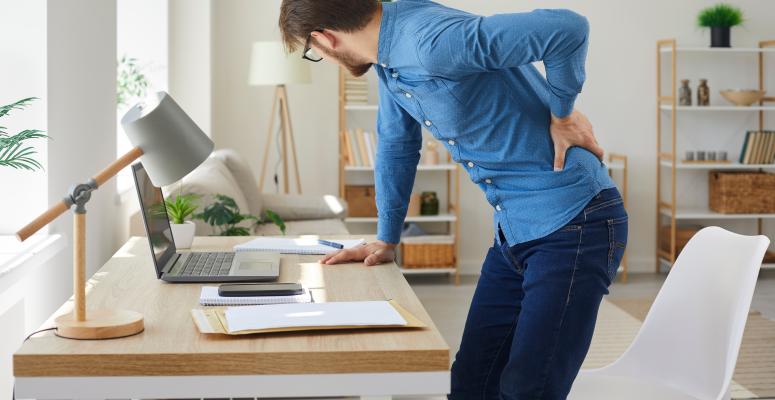
If you are suffering from lower back pain, you are not alone. Back pain is one of the most common reasons people miss work to see a doctor. It’s estimated that in the last three months, 25% of people in the U.S. have experienced lower back pain and about 80% of American adults will experience lower back pain at some point. This pain can range from dull to intense. It often can resolve on its own, but it can also linger. If you find yourself dealing with lower back pain more frequently than you’d care to, physical therapy can help.
Who can find lower back pain relief in physical therapy?
While some people may be more susceptible to experiencing lower back pain, anyone who experiences lower back pain can benefit from physical therapy. In one study, less than one-third of people struggling with chronic lower back pain sought the relief physical therapy can help provide. This could be due to the fear that physical therapy will hurt, they don’t have time for physical therapy, or maybe they think physical therapy isn’t intended for them. However, physical therapy can be beneficial if treatment is sought out. In one study, over 60% of patients experienced improvement in their lower back pain.
It can be tempting when experiencing lower back pain to stay on the couch or in bed. However, this is not ideal and could lead to worsened pain. Physical therapy for your lower back pain would be the better choice. Anyone can benefit from seeking physical therapy. Some may find it more beneficial to seek physical therapy, such as:
- Athletes — Athletes can be at a higher risk for lower back injuries due to the stress, pressure absorption, twisting, turning and impacts that the body goes through in different sports. Even the most elite of athletes are susceptible to injuries. It is estimated that up to 10% of athletic injuries are lower back injuries. Athletes most susceptible to lower back pain include gymnasts, divers, golfers, weightlifters, soccer players and rowers. Physical therapy can be beneficial for athletes to minimize their downtime due to lower back pain.
- Manual labor workers — Those people who work a manual labor job put their body through the ringer and can be more susceptible to lower back pain. Chronic lower back pain leads to a work disability, absence or employment loss in up to 10% of working individuals. The risk of pain is increased in those whose jobs involve lifting, pulling or pushing at least 25 pounds or working jobs with long periods of standing and walking. If this describes you, physical therapy can help relieve pain you are experiencing.
- New parents — New parents can be susceptible to lower back pain. Mothers in particular can experience it. It’s very common to experience pain in the lower back after pregnancy. Up to 20% of women experience discomfort up to six months after delivery. For a new mother, the extra weight gained during pregnancy and change of the body after pregnancy has led to more work for the muscles and stress on the joints. Both new parents can experience lower back pain due to lifting the baby, leaning over the baby bed, and wrestling with the stroller or car seat. Physical therapy can help you learn better posture and lifting form to help prevent worsening lower back pain and help improve the pain you’re experiencing.
Physical therapy treatments that can be beneficial for lower back pain
Physical therapy can be incredibly beneficial for lower back pain. Techniques used can include:
- Ultrasound — Therapeutic ultrasound can help deliver energy into the deep soft tissue via ultrasonic waves. This can help increase tissue temperature, which can help improve circulation and help relieve pain.
- Manual therapy — Manual therapy techniques can help provide pain relief and improve mobility in areas of the lower back that are restricted. Manual therapy techniques include soft tissue mobilization, joint mobilization and strain-counterstrain.
- Dry needling — Dry needling is a form of myofascial trigger point release. A certified practitioner inserts thin, sterile needles into a trigger point. This can help release pain and improve range of motion. It also helps improve circulation, which can help ease muscle tension.
- Hydrotherapy — Hydrotherapy can be a beneficial physical therapy treatment to help lower back pain due to natural buoyancy of water and the lessened pressure on the back. It can help reduce pain and improve your range of motion.
- Electrical stimulation — Electrical stimulation can help stop pain signals from your lower back to your brain. It also can help strengthen muscles and improve circulation.
Everyone has a back and can experience lower back pain, but some people are more susceptible than others. No matter your athletic ability or profession, seeking physical therapy can help.
Alliance PTP can connect you with the physical therapy practice you need for lower back pain treatment
Ready to try in-person physical therapy for your lower back pain? You’ll find plenty of options to choose from among the Alliance Physical Therapy Partners practices nationwide.
Our team can quickly put you in touch with one of our partner clinics near you, and their friendly and knowledgeable local staff can help you find care for your lower back pain.
Don’t have the time to see a physical therapist in person? Not a problem. Alliance PTP and its partners can also see you virtually in nearly every state.
Still have questions about what we and our partners can do for you? We’re ready to answer them and help you find the physical therapy you need.
Get Help at a Location Near You
